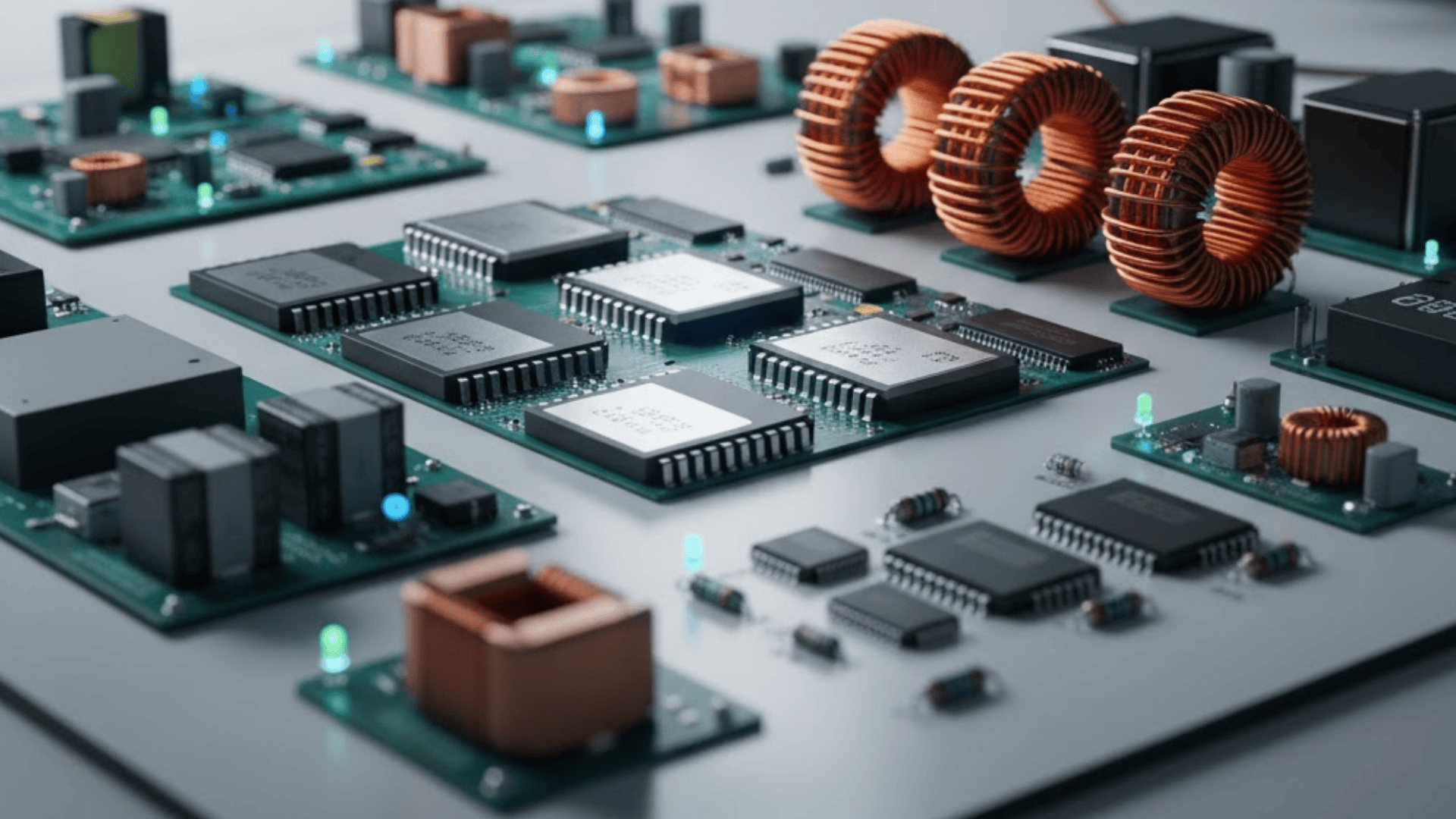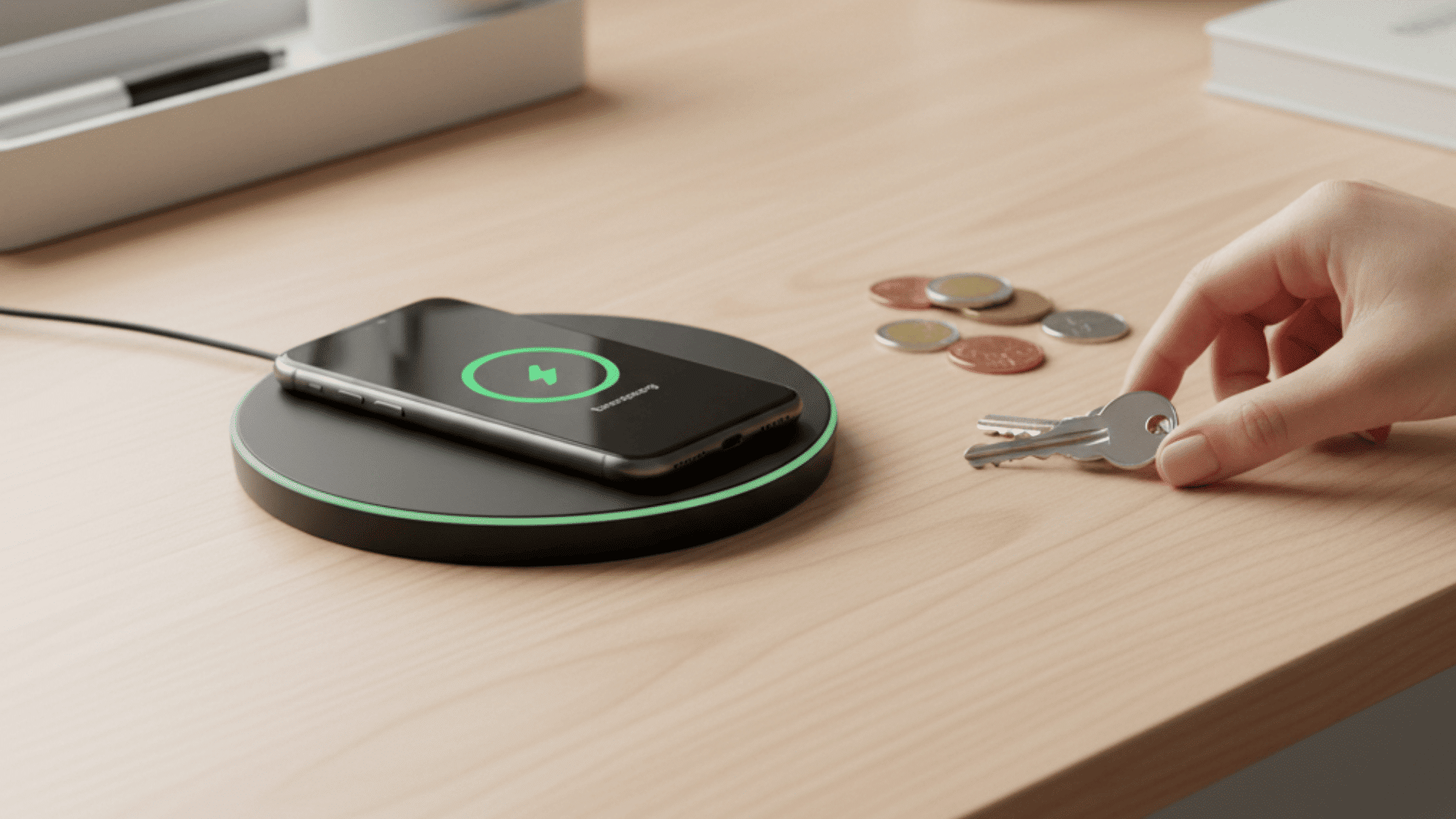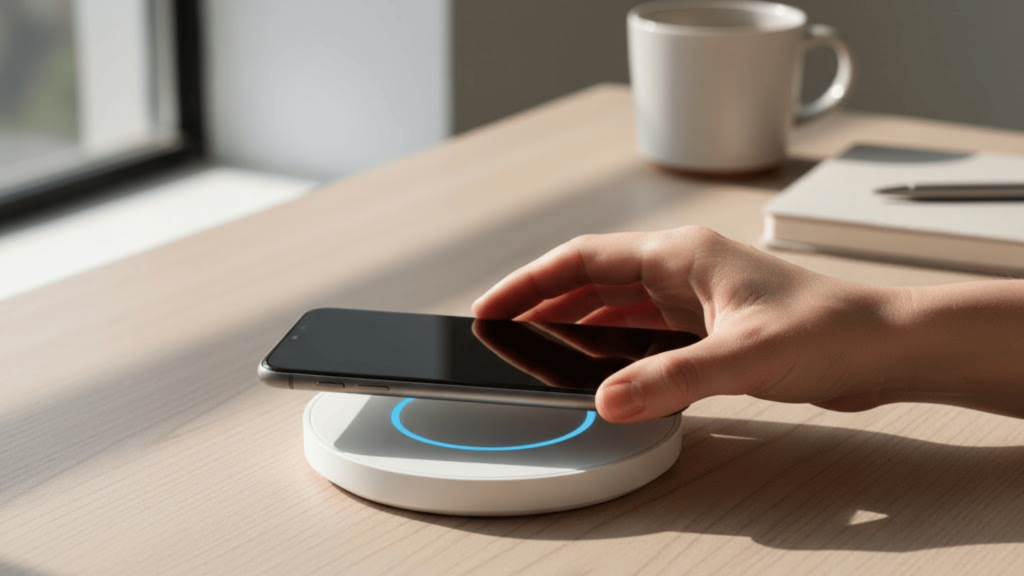Have you ever wished you could power your devices without dealing with tangled cables and worn-out charging ports every single day? Induction charging makes that dream a reality by transferring energy wirelessly through invisible electromagnetic fields instead of physical connections.
I’ve broken down this technology into simple explanations so you can understand exactly how it works and why it matters. You’ll learn why phones charge when you simply set them down and how electric buses refuel without needing to plug in anything.
The science behind induction charging isn’t complicated once you see it explained in straightforward steps anyone can follow. Let me walk you through everything about induction charging.
This content is for informational purposes only and should not replace professional advice from certified technicians or electrical engineers.
What Is Induction Charging?
Induction charging, also called wireless or contactless charging, lets you power devices without plugging cables directly into them.
This technology transfers energy between two objects using electromagnetic fields instead of physical wires or direct electrical contact between surfaces.
The basic concept relies on electromagnetic induction, where electricity flowing through one coil creates a magnetic field that generates power.
When you place your phone on a charging pad, energy moves wirelessly from the pad into your device’s battery.
Traditional plug-in charging requires you to insert a cable into a port, creating a physical connection each time. Induction charging eliminates wear on charging ports and makes powering up as simple as setting your device down.
How Induction Charging Works


Induction charging uses electromagnetic fields to transfer power wirelessly between a charging pad and your device without any cables. Understanding the core principle, essential components, and step-by-step process helps you see exactly how this convenient technology works:
The Principle of Electromagnetic Induction
Electromagnetic induction follows Faraday’s law, which states that a changing magnetic field can generate electricity in a nearby coil.
When electricity flows through the transmitter coil inside your charging pad, it creates a magnetic field that oscillates rapidly. The receiver coil inside your phone detects this changing magnetic field and converts it back into electricity for charging.
This conversion happens automatically without any physical connection between the charger and your device.
Key Components of an Inductive Charger
An inductive charging system relies on several essential parts working together to transfer power safely and efficiently to your device. Here are the main components that make wireless charging possible:
- Transmitter Coil: This copper wire coil sits inside the charging pad or station and creates the magnetic field that carries energy.
- Receiver Coil: Located inside your device, like a phone or electric vehicle, this coil captures the magnetic field and converts it.
- Power Source: An adapter plugs into the wall outlet and supplies electrical power to the transmitter coil inside the charging pad.
- Controller: Electronic circuits regulate energy flow, manage charging speed, prevent overheating, and ensure safe operation throughout the charging process.
These components work together to deliver power without cables or plugs every time you charge your device wirelessly.
Step-by-Step Process
Understanding the charging sequence helps you see exactly how energy travels wirelessly from the pad into your device’s battery. Here’s what happens during each stage of the induction charging process:
- Electrical power from your wall outlet reaches the transmitter coil inside the charging pad through the power adapter cable.
- The transmitter coil uses this electricity to create an oscillating magnetic field that extends upward from the charging pad’s surface.
- The receiver coil inside your device picks up this magnetic field when placed close enough to the charging pad surface.
- The receiver coil converts the magnetic field back into an electrical current that flows toward your device’s battery management system safely.
- This converted electrical energy charges your battery while built-in controllers monitor temperature, voltage, and charging speed for safety throughout.
The entire process requires your device to sit within a short range and maintain proper alignment with the charging pad. Even small gaps or misalignment can reduce charging efficiency or stop the power transfer completely until you reposition your device.
Types of Inductive Charging Systems


Induction charging isn’t one-size-fits-all because different systems serve different uses based on distance, power needs, and device types. Here are the main categories of inductive charging technology you’ll encounter today:
1. Near-Field Induction
Near-field induction is the most common wireless charging method you see with smartphones, smartwatches, earbuds, and other small electronics daily.
This system works over very short distances, typically just a few millimeters between the charging pad and your device. You need precise alignment for efficient charging, which is why phone chargers often have alignment guides or magnetic features.
2. Resonant Inductive Charging
Resonant inductive charging uses tuned coils that operate at the same frequency, allowing power transfer over slightly longer distances than near-field.
This system works even when devices aren’t perfectly aligned on the charging pad, giving you more placement flexibility and convenience. It can effectively charge multiple devices simultaneously when placed within range of a single station or pad.
3. Long-Range Wireless Power Transfer
Long-range wireless power transfer remains under active development for industrial equipment, electric vehicles, and large-scale commercial applications where cables aren’t practical.
This technology uses stronger magnetic resonance or hybrid technologies to transmit power across several feet instead of mere inches. Though promising, this technology faces technical challenges around energy loss, cost, and regulatory approval before widespread adoption.
Dynamic & In-Motion (On-Road) Wireless Charging
Dynamic wireless charging represents the cutting edge of induction technology by powering electric vehicles while they drive on special roadways.
This revolutionary concept implants charging coils directly into road surfaces, transferring energy to vehicles moving at highway speeds without stopping.
Real-world pilot projects and trials are currently testing this technology in Sweden, South Korea, and Germany to prove it works.
Advanced vehicle position control systems using AI methods optimize the magnetic coupling between road coils and vehicle receivers for maximum efficiency.
However, dynamic charging faces significant challenges, including high energy loss, complex infrastructure requirements, safety concerns, and enormous installation costs today.
Common Applications of Induction Charging
Induction charging has moved beyond smartphones and now powers everything from medical implants to electric buses in cities worldwide. Let me show you where this wireless technology makes the biggest impact across different industries and everyday life:
| Application Area | Common Devices | Charging Range | Power Level | Common Use Cases |
|---|---|---|---|---|
| Consumer Electronics | Phones, smartwatches, earbuds, and electric toothbrushes | Few millimeters | Low to medium | Home charging, office desks, public charging stations |
| Electric Vehicles (EVs) | Wireless charging pads for cars, buses, fleet vehicles | Few centimeters | High | Parking lots, public transport depots, taxi fleet stations |
| Medical Devices and Industrial Tools | Hearing aids, pacemakers, cochlear implants, and factory robotics | Few millimeters to centimeters | Low to medium | Hospitals, manufacturing plants, sterile environments, and underwater equipment |
These diverse applications show how induction charging solves practical problems across multiple sectors by eliminating cables and physical connections. As the technology improves, expect to see wireless charging expand into even more areas of daily life and industry.
Technical Innovations & Hardware Enablers


Induction charging technology keeps improving as engineers develop better materials, smarter circuits, and more efficient designs for future wireless power systems.
Gallium nitride inverters make power conversion more efficient by reducing energy loss and generating less heat than traditional silicon-based components.
Metasurfaces and free-positioning coil arrays let you place devices anywhere on charging pads without needing perfect alignment for effective charging.
Advanced cooling systems and thermal management techniques prevent overheating issues that currently limit charging speeds and reduce battery lifespan over time.
Control algorithms with adaptive tuning automatically adjust power delivery based on device needs, distance, and environmental conditions for optimal performance.
These innovations work together to make wireless charging faster, safer, and more convenient for everyday use across all devices.
Comparison with Alternative Charging Technologies
Different charging technologies offer unique advantages depending on your specific needs, vehicle type, and usage patterns throughout the day. Here’s how inductive charging compares with other available options for powering electric vehicles and devices:
| Technology | Description | Speed | Convenience | Best For |
|---|---|---|---|---|
| Wired DC Fast Charging | Direct cable connection to the vehicle | Very fast | Requires manual plugging | Highway stops, long trips |
| Inductive Charging | Wireless power through electromagnetic fields | Moderate | Hands-free, automatic | Home parking, fleet depots |
| Battery Swapping | Replace the depleted battery with a charged one | Fastest | Fully automated | Commercial fleets, taxis |
| Robotic Arms | The automated robot plugs in the cable | Fast | Hands-free automation | Parking garages, premium sites |
| Plug-and-Charge | Auto-authentication when plugged manually | Fast | Semi-automated | Public charging networks |
| Hybrid (Wired + Wireless) | Both wired and wireless options are available | Variable | Maximum flexibility | Premium vehicles, multi-use |
Each technology serves different purposes, and choosing the right one depends on balancing speed, convenience, and your daily usage. Inductive charging shines when automation and ease of use matter more than achieving the absolute fastest charging times possible.
Safety and Standards


Induction charging follows strict safety standards to protect users from electromagnetic interference and potential hazards during everyday use. Following best practices and understanding these standards helps you charge devices safely:
- Qi certification ensures compatibility: The Qi standard, established by the Wireless Power Consortium, certifies chargers and devices for safe, reliable wireless charging worldwide.
- Electromagnetic interference limits exist: Regulatory bodies set strict EMI limits to prevent wireless chargers from interfering with medical devices, WiFi signals, or other electronics nearby.
- Avoid metal objects on charging pads: Remove coins, keys, credit cards, or metal accessories from the charging surface to prevent overheating, sparks, or charging interruption.
- Thick cases may block charging: Remove very thick phone cases, metal cases, or cases with magnetic attachments if your device won’t charge properly or efficiently.
These safety measures protect both your devices and your home from potential issues during wireless charging sessions. Always buy certified chargers from reputable brands rather than cheap knockoffs that may lack proper safety features.
Advantages of Induction Charging
Induction charging isn’t just about convenience because it also improves safety, durability, and design flexibility in ways wired charging simply cannot. Here are the main benefits that make wireless charging increasingly popular across different devices and applications:
- No exposed metal contacts: Eliminates shock risk and prevents corrosion since there are no metal charging pins or ports exposed to moisture or dirt.
- Waterproof and dustproof designs are possible: Devices can be completely sealed without charging port openings, making them perfect for outdoor, marine, or industrial environments.
- Works through non-metallic surfaces: Power transfers through plastic, glass, or ceramic materials, allowing charging pads to be built into furniture, counters, or vehicle dashboards.
- Quiet operation and minimal maintenance: No mechanical parts wear out, connectors don’t break, and the system operates silently without moving parts or clicking sounds.
These advantages make induction charging ideal for situations where durability, safety, and integration matter more than charging speed alone. As technology improves, these benefits will make wireless charging the preferred option for an increasing number of devices and applications.
Limitations and Challenges
Despite its benefits, induction charging still has a few drawbacks to consider before choosing it over traditional wired charging methods. Understanding these limitations helps you decide when wireless charging makes sense and when wired options work better:
| Limitation | Technical Cause | Impact on Users | Workarounds |
|---|---|---|---|
| Lower Energy Efficiency | Energy loss through air gaps and coil resistance | Higher electricity costs, wasted energy | Use Qi-certified chargers |
| Slower Charging Speed | Power transfer limitations through electromagnetic fields | Longer charging times, inconvenient for quick top-ups | Fast wireless charging up to 15W |
| Limited Range and Alignment | Magnetic field weakens with distance | Charging stops if misaligned or moved | Magnetic alignment, larger charging surfaces |
| Heat Buildup | Energy loss converts to thermal energy | Reduced battery lifespan, device discomfort | Cooling fans, thermal sensors |
| Higher Manufacturing Cost | Additional specialized components required | More expensive products overall | Costs decrease with wider adoption |
These challenges explain why wired charging still dominates in situations where speed, efficiency, and cost matter most to users. As technology advances, manufacturers continue working to reduce these drawbacks and make wireless charging more competitive with traditional cables.
The Future of Induction Charging
Induction charging technology stands at the edge of revolutionary breakthroughs that will reshape how we power vehicles and devices forever.
Engineers are developing megawatt wireless charging systems specifically designed for heavy trucks and buses that need enormous power quickly at depots.
Fully autonomous wireless charging will let self-driving vehicles park and charge themselves without any human intervention or supervision whatsoever.
Embedded charging roads with smart infrastructure will power vehicles during their commute, eliminating the need for traditional charging stops completely.
AI and predictive control systems will self-optimize charging based on vehicle needs, grid conditions, and electricity prices in real time.
That’s a Wrap
Wireless power through induction charging is reshaping how you interact with technology every single day, without even realizing it’s happening.
I genuinely hope this breakdown helped you see the science, benefits, and real-world applications that make this technology so appealing.
Sure, it’s not perfect yet with the slower speeds and heat issues, but engineers are working hard to fix those problems. The technology keeps getting better as manufacturers figure out ways to charge faster and waste less energy during the process.
Your next phone, car, or even your kitchen counter might come with wireless charging built right in without you even asking. What device do you wish had induction charging that doesn’t offer it yet? Share your thoughts in the comments below.

